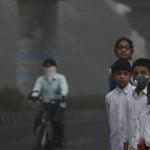
Air pollution levels remain dangerously high in many parts of the world with nine out of 10 people breathing air containing high levels of pollutants, the World Health Organization (WHO) said on Wednesday.
It praised India’s Pradhan Mantri Ujjwala Yojana Scheme for providing some 37 million free liquefied petroleum gas (LPG) connections in the past two years that help promoting the use of clean household energy.
The WHO’s updated estimations reveal around 90 per cent of people worldwide breathe polluted air and an alarming death toll of seven million people every year caused by ambient (outdoor) and household air pollution.
“Air pollution threatens us all, but the poorest and most marginalized people bear the brunt of the burden,” WHO Director-General Tedros Adhanom Ghebreyesus said in a statement.
“It is unacceptable that over three billion people — most of them women and children — are still breathing deadly smoke every day from using polluting stoves and fuels in their homes. If we don’t take urgent action on air pollution, we will never come close to achieving sustainable development.”
The UN body launched its latest data on air pollution levels for more than 4,000 cities in over 100 countries as well the estimated health effects from both ambient and household air pollution.
Air pollution represents the biggest environmental risk to health. Yet solutions exist and the data shows some countries have made substantial progress.
WHO estimates that around seven million people die every year from exposure to fine particles in polluted air that penetrate deep into the lungs and cardiovascular system, causing diseases including stroke, heart disease, lung cancer, chronic obstructive pulmonary diseases and respiratory infections, including pneumonia.
Ambient air pollution alone caused some 4.2 million deaths in 2016, while household air pollution from cooking with polluting fuels and technologies caused an estimated 3.8 million deaths in the same period.
More than 90 per cent of air pollution-related deaths occur in low and middle-income countries, mainly in Asia and Africa, followed by low and middle-income countries of the Eastern Mediterranean region, Europe and the Americas.
Around three billion people — more than 40 per cent of the world’s population — still do not have access to clean cooking fuels and technologies in their homes, the main source of household air pollution.
WHO has been monitoring household air pollution for more than a decade and, while the rate of access to clean fuels and technologies is increasing everywhere, improvements are not even keeping pace with population growth in many parts of the world, particularly in sub Saharan Africa.
WHO recognises that air pollution is a critical risk factor for non-communicable diseases (NCDs), causing an estimated one-quarter (24 per cent) of all adult deaths from heart disease, 25 per cent from stroke, 43 per cent from chronic obstructive pulmonary disease and 29 per cent from lung cancer.
More than 4,300 cities in 108 countries are now included in WHO’s ambient air quality database, making this the world’s most comprehensive database on ambient air pollution.
Since 2016, more than 1,000 additional cities have been added to WHO’s database which shows that more countries are measuring and taking action to reduce air pollution than ever before.
The database collects annual mean concentrations of fine particulate matter (PM10 and PM2.5).
PM2.5 includes pollutants, such as sulfate, nitrates and black carbon, which pose the greatest risks to human health.
WHO air quality recommendations call for countries to reduce their air pollution to annual mean values of 20 Ig/m3 (for PM10) and 10 Ig/m3 (for PM25).
“Many of the world’s megacities exceed WHO’s guideline levels for air quality by more than five times, representing a major risk to people’s health,” said Maria Neira, Director of the Department of Public Health, Social and Environmental Determinants of Health, at WHO.
“We are seeing an acceleration of political interest in this global public health challenge. The increase in cities recording air pollution data reflects a commitment to air quality assessment and monitoring. Most of this increase has occurred in high-income countries, but we hope to see a similar scale-up of monitoring efforts worldwide.”
While the latest data show ambient air pollution levels are still dangerously high in most parts of the world, they also show some positive progress.
Countries are taking measures to tackle and reduce air pollution from particulate matter.
For example, in just two years, India’s Pradhan Mantri Ujjwala Yojana Scheme has provided some 37 million women living below the poverty line with free LPG connections to support them to switch to clean household energy use.
Likewise, Mexico City has committed to cleaner vehicle standards, including a move to soot-free buses and a ban on private diesel cars by 2025.
[“source=hindustantimes”]



